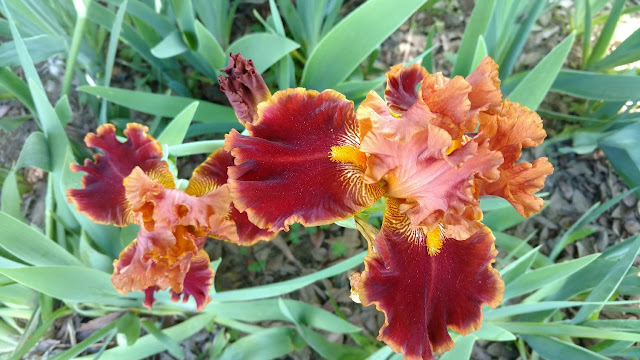
Now is the time to plant this beautiful water-wise perennial

|
|
To get beautiful iris blooms like this, plant rhizomes in midsummer. Find a huge selection of rhizomes at the Sacramento Iris Society sale this weekend. (Photo: Debbie Arrington)
|
Bearded irises rank among the best drought-tolerant perennials for Sacramento gardens. And here’s your chance to get a bunch to plant now.
On Saturday and Sunday, July 16 and 17, the Sacramento Iris Society will host its annual rhizome sale at Shepard Garden and Arts Center. Think of it as a bare-root sale for irises; rhizomes are irises’ fleshy underground stems.
Mid to late summer is the best time to plant (or divide and transplant) bearded irises, which is why this plant sale is a mid-July staple. Bearded irises need very little summer irrigation, once established. Planted now, they’ll bloom next March and April.
The iris is named for the Greek goddess of the rainbow because the flowers come in so many hues. Find scores of varieties in every color (and many dazzling combinations) from pure white to (almost) pure black. Reblooming irises – which produce flowers in both spring and fall – will also be available.
Sale hours are 9 a.m. to 3 p.m. each day. Parking and admission are free. Come early for the best selection. Club members will be on hand to offer advice, not just in choosing varieties but how to care for those rhizomes once you get them home and how to keep them thriving for years ahead.
Shepard Center is located at 3330 McKinley Blvd., Sacramento.
Details: https://sacramentoirissocietydotcom.wordpress.com/
Comments
0 comments have been posted.Sacramento Digs Gardening to your inbox.
Food in My Back Yard Series
April 1: Don't be fooled by these garden myths
March 25: Fertilizer tips: How to 'feed' your vegetables for healthy growth
March 18: Time to give vegetable seedlings some more space
March 11: Ways to win the fight against weeds
March 4: Potatoes from the garden
Feb. 25: Plant a fruit tree now -- for later
Feb. 18: How to squeeze more food into less space
Feb. 11: When to plant? Consider staggering your transplants
Feb. 4: Starting in seed starting
Sites We Like
Garden Checklist for week of March 30
Your garden doesn’t mind April showers. Get busy now to enjoy those future flowers.
* Get ready to swing into action in the vegetable garden. As nights warm up over 50 degrees, start setting out tomato, pepper and eggplant transplants.
* From seed, plant beans, beets, cantaloupes, carrots, corn, cucumbers, melons, pumpkins, radishes and squash. (Soak beet seeds overnight in water for better germination,)
* Plant onion sets.
* In the flower garden, plant seeds for asters, cosmos, celosia, marigolds, salvia, sunflowers and zinnias.
* Transplant petunias, zinnias, geraniums and other summer bloomers.
* Plant perennials and dahlia tubers for summer bloom.
* Transplant lettuce and cabbage seedlings.
* April is the last chance to plant citrus trees such as dwarf orange, lemon and kumquat. These trees also look good in landscaping and provide fresh fruit in winter.
* Smell orange blossoms? Feed citrus trees with a low dose of balanced fertilizer (such as 10-10-10) during bloom to help set fruit. Keep an eye out for ants.
* Apply slow-release fertilizer to the lawn.